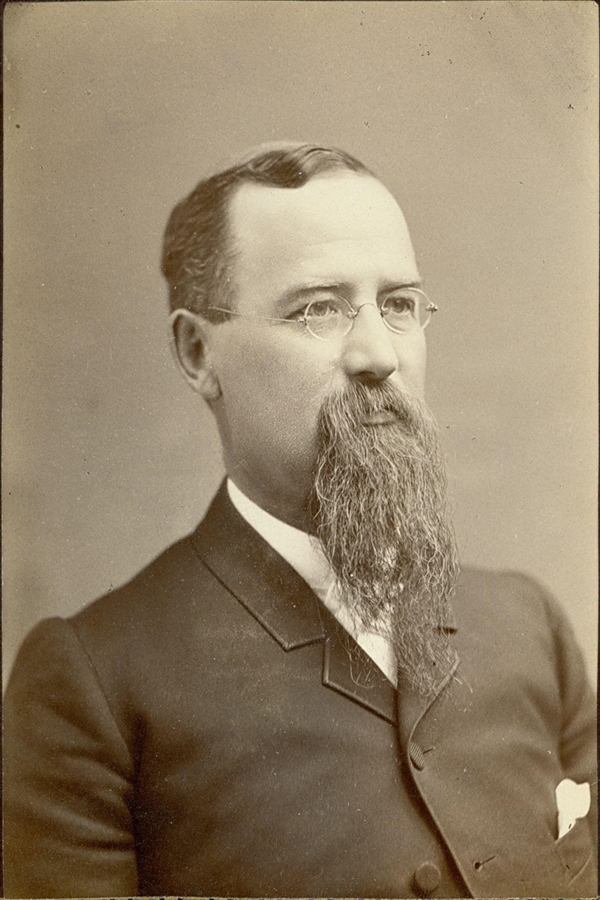Written by Dexter Neustadt
John William Stearns, president of the Whitewater Normal School from 1878 – 1885, served as a welcome contrast to his predecessor William F. Phelps. The presidency of William F. Phelps was unpopular among the school’s faculty and students. The pedagogy and administration were systematic and mechanical, and Phelps’s term came to a tempestuous finale in 1878. Following the resignation of Phelps, the normal school’s teacher education programs flourished under the presidency of John William Stearns.

Born in Stockbridge, Massachusetts, in 1839, John W. Stearns graduated from Harvard University in 1860 before gaining teaching and leadership experience across the United States and abroad. He taught at the Normal School in Winona, Minnesota; he was a high school principal in Canton, Illinois; a Latin professor at the University of Chicago; and the director of the National Normal School in Tucuman, Argentina.[1] Upon President Phelps’s resignation, the school’s Board of Regents selected Stearns as the next president in 1878.[2]
During his tenure at the Whitewater Normal School, Stearns drastically improved teacher education, student and faculty life and culture, and the library. A foe of formalism, Stearns was opposed to “excessive bookishness.”[3] He believed “the letter killeth, but the spirit giveth life.”[4] As such, he approached his leadership with a courteous and kind disposition fostering esteem and cooperation among the students and faculty. Additionally, Stearns’s morning talks to the school left lasting impressions, and he promoted voluntary observance of school regulations rather than strictly enforcing rules. While maintaining high standards of conduct, the normal school became less formal and rigid in contrast to Phelps’s presidency.[5]
President Stearns directly improved teacher education by advocating for additional time for students to focus on understanding the basic principles so as to eliminate the “mechanical conceptions of teaching.”[6] In 1881, the Board of Regents heard his appeal and allotted an additional six months to the elementary course so that students could concentrate on philosophical comprehension of principles.[7] The implementation of a shop-work course also enhanced teacher education. Apropos of his opinion about excessive bookishness, Stearns believed that woodworking knowledge would develop all students– especially women– by making them more independent and “self-helpful.”[8] Finally, Stearns augmented the library by expanding the reference library from 600 volumes to 1,586 volumes.[9] This addition to the library’s collection meant that Whitewater Normal School could boast the most extensive library of general books of the four normal schools in Wisconsin.[10]
Stearns’s presidency at the Whitewater Normal School ended in 1885 when he accepted an invitation from the State University of Madison as the chair of pedagogy, and students and faculty alike regretted seeing him leave.[11] While he was known for his broad, quickening, and liberalizing influences on campus, J. W. Stearns inspired students to strive for their highest attainable results.
[1] Albert Salisbury, Historical Sketches of The First Quarter-Century of The State Normal School At Whitewater, Wisconsin With a Catalog of Its Graduates and a Record of Their Work: 1868-1893, (Madison: Tracy, Gibbs & Co, 1893), 127.
[2] “President Stearns,” The Whitewater Register, August 15th, 1878.
[3] Board of Regents, First Biennial Report, 1882-84.
[4] Salisbury, 9.
[5] Salisbury, 127.
[6] Mary Janette Bohi, A History of Wisconsin State University Whitewater 1868-1968 (Whitewater: Whitewater State University Foundation Inc, 1967), 62.
[7] Bohi, 62.
[8] Bohi, 63.
[9] Bohi, 61-62.
[10] Bohi, 61.
[11] Salisbury, 10.

Way to go John William Stearns!
Great profile on Pres. Stearns!